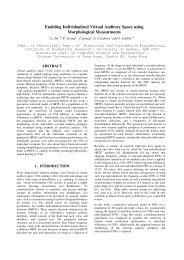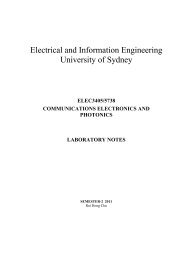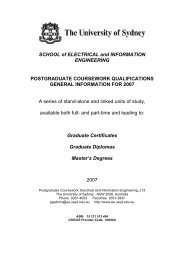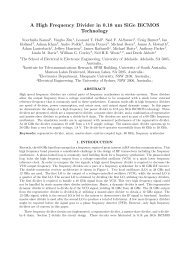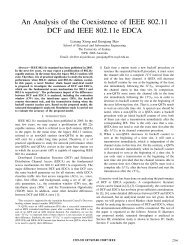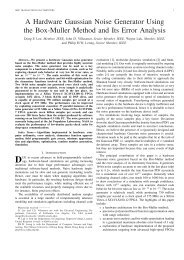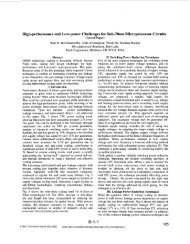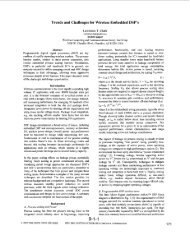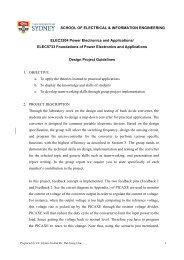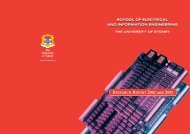Near-capacity turbo trellis coded modulation design based on union ...
Near-capacity turbo trellis coded modulation design based on union ...
Near-capacity turbo trellis coded modulation design based on union ...
You also want an ePaper? Increase the reach of your titles
YUMPU automatically turns print PDFs into web optimized ePapers that Google loves.
2030 IEEE TRANSACTIONS ON COMMUNICATIONS, VOL. 56, NO. 12, DECEMBER 2008<br />
Transacti<strong>on</strong>s Papers<br />
<str<strong>on</strong>g>Near</str<strong>on</strong>g>-Capacity Turbo Trellis Coded Modulati<strong>on</strong><br />
Design Based <strong>on</strong> EXIT Charts and Uni<strong>on</strong> Bounds<br />
So<strong>on</strong> Xin Ng, Senior Member, IEEE, OsamahRashedAlamri,Student Member, IEEE, Y<strong>on</strong>ghui Li, Member, IEEE,<br />
Jörg Kliewer, Senior Member, IEEE, and Lajos Hanzo, Fellow, IEEE<br />
Abstract—Bandwidth efficient parallel-c<strong>on</strong>catenated Turbo<br />
Trellis Coded Modulati<strong>on</strong> (TTCM) schemes were <str<strong>on</strong>g>design</str<strong>on</strong>g>ed for<br />
communicating over uncorrelated Rayleigh fading channels. A<br />
symbol-<str<strong>on</strong>g>based</str<strong>on</strong>g> uni<strong>on</strong> bound was derived for analysing the error<br />
floor of the proposed TTCM schemes. A pair of In-phase (I) and<br />
Quadrature-phase (Q) interleavers were employed for interleaving<br />
the I and Q comp<strong>on</strong>ents of the TTCM <str<strong>on</strong>g>coded</str<strong>on</strong>g> symbols, in order<br />
to attain an increased diversity gain. The decoding c<strong>on</strong>vergence<br />
of the IQ-TTCM schemes was analysed using symbol-<str<strong>on</strong>g>based</str<strong>on</strong>g><br />
EXtrinsic Informati<strong>on</strong> Transfer (EXIT) charts. The best TTCM<br />
comp<strong>on</strong>ent codes were selected with the aid of both the symbol<str<strong>on</strong>g>based</str<strong>on</strong>g><br />
uni<strong>on</strong> bound and n<strong>on</strong>-binary EXIT charts, for <str<strong>on</strong>g>design</str<strong>on</strong>g>ing<br />
<str<strong>on</strong>g>capacity</str<strong>on</strong>g>-approaching IQ-TTCM schemes in the c<strong>on</strong>text of 8PSK,<br />
16QAM, 32QAM and 64QAM <str<strong>on</strong>g>modulati<strong>on</strong></str<strong>on</strong>g> schemes.<br />
Index Terms—Decoding c<strong>on</strong>vergence, distance spectrum, code<br />
<str<strong>on</strong>g>design</str<strong>on</strong>g>, EXIT charts, Turbo Trellis Coded Modulati<strong>on</strong>, uni<strong>on</strong><br />
bound.<br />
I. INTRODUCTION<br />
TRELLIS Coded Modulati<strong>on</strong> (TCM) [1] was originally<br />
proposed for transmissi<strong>on</strong> over Additive White Gaussian<br />
Noise (AWGN) channels, but later it was further developed<br />
for applicati<strong>on</strong>s in mobile communicati<strong>on</strong>s [2], [3], since it<br />
accommodates all the parity bits by expanding the signal<br />
c<strong>on</strong>stellati<strong>on</strong>, rather than increasing the bandwidth requirement.<br />
Turbo Trellis Coded Modulati<strong>on</strong> (TTCM) [4] is a more<br />
recent joint coding and <str<strong>on</strong>g>modulati<strong>on</strong></str<strong>on</strong>g> scheme that has a structure<br />
similar to that of the family of power-efficient binary <str<strong>on</strong>g>turbo</str<strong>on</strong>g><br />
codes [5], but employs two identical parallel c<strong>on</strong>catenated<br />
TCM schemes as comp<strong>on</strong>ent codes. A symbol-<str<strong>on</strong>g>based</str<strong>on</strong>g> <str<strong>on</strong>g>turbo</str<strong>on</strong>g><br />
interleaver is used between the two TCM encoders and the<br />
en<str<strong>on</strong>g>coded</str<strong>on</strong>g> symbols of each comp<strong>on</strong>ent code are punctured<br />
alternatively for the sake of achieving a higher bandwidth efficiency<br />
as detailed in [4], [6]. The <str<strong>on</strong>g>design</str<strong>on</strong>g> of the TTCM scheme<br />
Paper approved by C. Schlegel, the Editor for Coding Theory and Techniques<br />
of the IEEE Communicati<strong>on</strong>s Society. Manuscript received November<br />
6, 2006; revised November 6, 2007.<br />
S. X. Ng, O. R. Alamri, and L. Hanzo are with the School of Electr<strong>on</strong>ics and<br />
Computer Science, University of Southampt<strong>on</strong>, SO17 1BJ, United Kingdom<br />
(e-mail: {sxn, ora02r, lh}@ecs.sot<strong>on</strong>.ac.uk).<br />
Y. Li is with the School of Electrical & Informati<strong>on</strong> Engineering, University<br />
of Sydney, Sydney, NSW, 2006, Australia (e-mail: lyh@ee.usyd.edu.au).<br />
J. Kliewer is with the Klipsch School of Electrical and Computer Engineering,<br />
New Mexico State University, Las Cruces, NM 88003, USA (e-mail:<br />
jkliewer@nmsu.edu).<br />
The financial support of the European Uni<strong>on</strong> under the auspices of the<br />
Newcom and Phoenix projects, as well as that of the EPSRC UK, the Ministry<br />
of Higher Educati<strong>on</strong> of Saudi Arabia and the German Research Foundati<strong>on</strong><br />
(DFG) is gratefully acknowledged.<br />
Digital Object Identifier 10.1109/TCOMM.2008.06039522<br />
0090-6778/08$25.00 c○ 2008 IEEE<br />
outlined in [4] was <str<strong>on</strong>g>based</str<strong>on</strong>g> <strong>on</strong> the search for the best comp<strong>on</strong>ent<br />
TCM codes using the so-called ‘punctured’ minimal distance<br />
criteri<strong>on</strong>, where the c<strong>on</strong>stituent TCM codes having the maximal<br />
‘punctured’ minimal distance were sought. However, the<br />
TTCM schemes <str<strong>on</strong>g>design</str<strong>on</strong>g>ed for AWGN channels in [4] would<br />
exhibit a high error floor, when communicating over Rayleigh<br />
fading channels, if any informati<strong>on</strong> bits are unprotected by the<br />
c<strong>on</strong>stituent comp<strong>on</strong>ent codes [7]. Hence, a different TTCM<br />
<str<strong>on</strong>g>design</str<strong>on</strong>g> is needed, when communicating over Rayleigh fading<br />
channels.<br />
It was shown in [2] that the maximisati<strong>on</strong> of the minimum<br />
Hamming distance measured in terms of the number of different<br />
symbols between any two transmitted symbol sequences is<br />
the key <str<strong>on</strong>g>design</str<strong>on</strong>g> criteri<strong>on</strong> for TCM schemes c<strong>on</strong>trived for uncorrelated<br />
Rayleigh fading channels, where the fading coefficients<br />
change independently from <strong>on</strong>e symbol to another. More<br />
specifically, Bit-Interleaved Coded Modulati<strong>on</strong> (BICM) [8]<br />
employing bit-<str<strong>on</strong>g>based</str<strong>on</strong>g> interleavers was <str<strong>on</strong>g>design</str<strong>on</strong>g>ed for increasing<br />
the achievable diversity order to the binary Hamming distance<br />
of a code for transmissi<strong>on</strong> over uncorrelated Rayleigh fading<br />
channels. A parallel-c<strong>on</strong>catenated Turbo BICM scheme was<br />
<str<strong>on</strong>g>design</str<strong>on</strong>g>ed in [9] and was analysed in [10] when communicating<br />
over Rayleigh fading channels, where a lower error floor is<br />
attained as a benefit of having a higher minimum Hamming<br />
distance. However, bit-interleaved <str<strong>on</strong>g>turbo</str<strong>on</strong>g> coding schemes have<br />
a poorer decoding c<strong>on</strong>vergence [11] compared to their symbolinterleaved<br />
counterparts due to the associated informati<strong>on</strong> loss,<br />
when invoking a bit-to-symbol probability c<strong>on</strong>versi<strong>on</strong> during<br />
each decoding iterati<strong>on</strong> [12]. Hence, it is desirable to reduce<br />
the error floor without using a bit-<str<strong>on</strong>g>based</str<strong>on</strong>g> interleaver in order to<br />
retain the good c<strong>on</strong>vergence properties of symbol-interleaved<br />
<str<strong>on</strong>g>turbo</str<strong>on</strong>g> coding schemes.<br />
More specifically, apart from using bit interleavers, the<br />
diversity order of a code can be increased with the aid of<br />
spatial diversity, frequency diversity and signal space diversity<br />
[13]. More explicitly, signal space diversity is obtained<br />
by employing two independent channel interleavers for separately<br />
interleaving the In-phase (I) and Quadrature-phase (Q)<br />
comp<strong>on</strong>ents of the complex-valued en<str<strong>on</strong>g>coded</str<strong>on</strong>g> signals, combined<br />
with c<strong>on</strong>stellati<strong>on</strong> rotati<strong>on</strong>. A TCM scheme <str<strong>on</strong>g>design</str<strong>on</strong>g>ed with<br />
signal space diversity was proposed in [14]. On the other<br />
hand, it was shown in [15] that a diversity gain may also be<br />
attained using IQ interleaving al<strong>on</strong>e – i.e. without c<strong>on</strong>stellati<strong>on</strong><br />
rotati<strong>on</strong> – in the c<strong>on</strong>text of TCM and TTCM schemes. The<br />
Authorized licensed use limited to: UNIVERSITY OF SYDNEY. Downloaded <strong>on</strong> January 4, 2009 at 20:22 from IEEE Xplore. Restricti<strong>on</strong>s apply.
NG et al.: NEAR-CAPACITY TURBO TRELLIS CODED MODULATION DESIGN BASED ON EXIT CHARTS AND UNION BOUNDS 2031<br />
diversity associated with IQ interleaving al<strong>on</strong>e was referred to<br />
as IQ-diversity [15], where the error floor of the IQ-diversity<br />
assisted TTCM (IQ-TTCM) schemes was lower than that of<br />
c<strong>on</strong>venti<strong>on</strong>al TTCM schemes [15]. Hence, we will <str<strong>on</strong>g>design</str<strong>on</strong>g> new<br />
TTCM schemes employing symbol-<str<strong>on</strong>g>based</str<strong>on</strong>g> <str<strong>on</strong>g>turbo</str<strong>on</strong>g> interleavers<br />
for attaining an early decoding c<strong>on</strong>vergence as well as separate<br />
I and Q channel interleavers for achieving a low error floor.<br />
Note that <str<strong>on</strong>g>turbo</str<strong>on</strong>g> codes exhibit low a Bit Error Rate (BER)<br />
in the low to medium Signal to Noise Ratio (SNR) regi<strong>on</strong><br />
due to their early decoding c<strong>on</strong>vergence. The asymptotic BER<br />
performance of a code at high SNR is mainly dominated by<br />
its minimum distance. However, the overall BER performance<br />
of a code is influenced not <strong>on</strong>ly by the minimum distance,<br />
but by several distance spectral comp<strong>on</strong>ents, in particular in<br />
the medium SNR regi<strong>on</strong> [16]–[18]. Hence, the accurate Distance<br />
Spectrum [19] analysis has to c<strong>on</strong>sider several distance<br />
spectral lines, when <str<strong>on</strong>g>design</str<strong>on</strong>g>ing a <str<strong>on</strong>g>turbo</str<strong>on</strong>g>-style code. Note further<br />
that the overall BER performance of a code is determined by<br />
both the effective Hamming distance and the effective product<br />
distance, when communicating over uncorrelated Rayleigh<br />
fading channels [2]. Hence, a two-Dimensi<strong>on</strong>al (2D) distance<br />
spectrum c<strong>on</strong>stituted by both the Hamming distance and<br />
product distance has to be evaluated [20]. Recently, a TTCM<br />
scheme employing bit-<str<strong>on</strong>g>based</str<strong>on</strong>g> <str<strong>on</strong>g>turbo</str<strong>on</strong>g> interleavers was proposed<br />
and analysed in [20], where the corresp<strong>on</strong>ding uni<strong>on</strong> bound<br />
of the BER was derived <str<strong>on</strong>g>based</str<strong>on</strong>g> <strong>on</strong> the 2D distance spectrum.<br />
However, the c<strong>on</strong>vergence of the bit-interleaved TTCM of [20]<br />
was again inferior compared to the symbol-interleaved TTCM<br />
<str<strong>on</strong>g>design</str<strong>on</strong>g>, despite having a lower error floor. We will derive the<br />
BER uni<strong>on</strong> bound for TTCM schemes employing symbol<str<strong>on</strong>g>based</str<strong>on</strong>g><br />
<str<strong>on</strong>g>turbo</str<strong>on</strong>g> interleavers in order to analyse their error floor<br />
performance.<br />
EXtrinsic Informati<strong>on</strong> Transfer (EXIT) charts c<strong>on</strong>stitute<br />
useful tools, when analysing the c<strong>on</strong>vergence properties of<br />
iterative decoding schemes. They have been invoked for<br />
analysing both c<strong>on</strong>catenated binary coding schemes [21] and<br />
n<strong>on</strong>-binary coding schemes [22], [23]. As a result, near<str<strong>on</strong>g>capacity</str<strong>on</strong>g><br />
codes have been successfully <str<strong>on</strong>g>design</str<strong>on</strong>g>ed by applying<br />
an EXIT chart <str<strong>on</strong>g>based</str<strong>on</strong>g> technique in [24], [25]. The novel<br />
c<strong>on</strong>tributi<strong>on</strong> of this paper is that we will employ the lowcomplexity<br />
symbol-<str<strong>on</strong>g>based</str<strong>on</strong>g> EXIT charts proposed in [23] and<br />
the corresp<strong>on</strong>ding BER uni<strong>on</strong> bound of the TTCM schemes in<br />
order to <str<strong>on</strong>g>design</str<strong>on</strong>g> new, near-<str<strong>on</strong>g>capacity</str<strong>on</strong>g> symbol-interleaved TTCM<br />
schemes. More specifically, new Generator Polynomials (GPs)<br />
are sought for the TCM comp<strong>on</strong>ent codes, <str<strong>on</strong>g>based</str<strong>on</strong>g> <strong>on</strong> their<br />
decoding c<strong>on</strong>vergence and <strong>on</strong> the error floor performance of<br />
the TTCM decoder, rather than <strong>on</strong> the ‘punctured’ minimal<br />
distance criteri<strong>on</strong> of the TCM comp<strong>on</strong>ent codes defined in [4].<br />
Our prime <str<strong>on</strong>g>design</str<strong>on</strong>g> criteri<strong>on</strong> is to find a c<strong>on</strong>stituent TCM code,<br />
where the corresp<strong>on</strong>ding EXIT charts exhibit an open tunnel at<br />
the lowest possible SNR value, as well as having an acceptable<br />
error floor as estimated by the truncated symbol-<str<strong>on</strong>g>based</str<strong>on</strong>g> uni<strong>on</strong><br />
bound.<br />
The rest of the paper is organised as follows. The system<br />
model is described in Secti<strong>on</strong> II. The novel symbol-<str<strong>on</strong>g>based</str<strong>on</strong>g><br />
uni<strong>on</strong> bound of the BER of the TCM and TTCM schemes<br />
are derived <str<strong>on</strong>g>based</str<strong>on</strong>g> <strong>on</strong> the 2D distance spectrum in Secti<strong>on</strong> III.<br />
An overview of the symbol-<str<strong>on</strong>g>based</str<strong>on</strong>g> EXIT charts is given in<br />
Secti<strong>on</strong> IV. Our novel c<strong>on</strong>stituent code search algorithm is<br />
u<br />
π s<br />
Fig. 1.<br />
u (1)<br />
m<br />
u (2)<br />
m<br />
RSC Encoder (1)<br />
2 m+1 -ary Mapper<br />
Upper TCM Encoder<br />
Lower TCM Encoder<br />
RSC Encoder (2)<br />
2 m+1 -ary Mapper<br />
x (1)<br />
2<br />
x (2)<br />
2<br />
π −1<br />
s<br />
Schematic of an IQ-TTCM encoder.<br />
Selector<br />
x<br />
2<br />
Re(.)<br />
Im(.)<br />
x =[x 1 x 2 ... x t ... x N ];<br />
x =[x (1)<br />
1 x (2)<br />
2 x (1)<br />
3 x (2)<br />
4 ...];<br />
1<br />
1<br />
π I<br />
π Q<br />
u =[u 1 u 2 ... u t ... u N ]; u t ∈ Z +<br />
x t ∈ C<br />
detailed in Secti<strong>on</strong> V and the resultant findings are presented<br />
and discussed in Secti<strong>on</strong> VI. Finally, our c<strong>on</strong>clusi<strong>on</strong>s are<br />
offered in Secti<strong>on</strong> VII.<br />
II. SYSTEM MODEL<br />
In this paper, we c<strong>on</strong>sider <strong>on</strong>ly two-dimensi<strong>on</strong>al TCM and<br />
TTCM schemes, where the code rate is given by R = m/(m+<br />
1), employing 2 m+1 -ary PSK/QAM signal sets. Hence the<br />
effective throughput is m bit per modulated symbol. A TCM<br />
encoder c<strong>on</strong>sists of a Recursive Systematic C<strong>on</strong>voluti<strong>on</strong>al<br />
(RSC) encoder and a signal mapper. An IQ-interleaved TTCM<br />
encoder employing two TCM comp<strong>on</strong>ent schemes is shown in<br />
Fig. 1. The N-symbol un<str<strong>on</strong>g>coded</str<strong>on</strong>g> and en<str<strong>on</strong>g>coded</str<strong>on</strong>g> symbol sequences<br />
are denoted as u and x, respectively. The superscripts (1)<br />
and (2) are used for differentiating the un<str<strong>on</strong>g>coded</str<strong>on</strong>g> and en<str<strong>on</strong>g>coded</str<strong>on</strong>g><br />
sequences bel<strong>on</strong>ging to the upper and lower TCM encoders,<br />
respectively. The I and Q channel interleavers, namely π I<br />
and π Q , are used for independently interleaving the I and Q<br />
comp<strong>on</strong>ents of the complex-valued en<str<strong>on</strong>g>coded</str<strong>on</strong>g> symbol sequence<br />
x.<br />
Note that a TTCM scheme employs an Odd-Even Separati<strong>on</strong><br />
(OES) <str<strong>on</strong>g>based</str<strong>on</strong>g> symbol interleaver π s as the <str<strong>on</strong>g>turbo</str<strong>on</strong>g><br />
interleaver, where odd (even) indexed symbols are mapped<br />
to another odd (even) positi<strong>on</strong> after interleaving. An OES<br />
symbol deinterleaver πs<br />
−1 is also used at the output of the<br />
lower TCM encoder. This ensures that after the alternative<br />
puncturing, which is performed by the ‘Selector’ block shown<br />
in Fig. 1, all even (odd) indexed symbols of the upper (lower)<br />
TCM comp<strong>on</strong>ent encoder are punctured [4]. Note that the<br />
informati<strong>on</strong> parts of each en<str<strong>on</strong>g>coded</str<strong>on</strong>g> symbol from the upper<br />
and lower TCM encoders before the ‘Selector’ block are<br />
identical. Hence, the informati<strong>on</strong> bits are transmitted exactly<br />
<strong>on</strong>ce. Let us denote the punctured en<str<strong>on</strong>g>coded</str<strong>on</strong>g> symbol as x0 (j)<br />
t<br />
for j ∈{1, 2}, wherethem informati<strong>on</strong> bits are retained, but<br />
the parity bit is set to zero. Hence, we may view the actual<br />
transmitted en<str<strong>on</strong>g>coded</str<strong>on</strong>g> symbol sequences from the upper and<br />
lower TCM encoders as:<br />
x (1) =[x (1)<br />
1 x0 (1)<br />
2 x (1)<br />
3 x0 (1)<br />
4 x (1)<br />
5 x0 (1)<br />
6 ...] , (1)<br />
and<br />
x (2) =[x0 (2)<br />
1 x (2)<br />
2 x0 (2)<br />
3 x (2)<br />
4 x (2)<br />
5 x0 (2)<br />
6 ...] , (2)<br />
respectively, while the TTCM en<str<strong>on</strong>g>coded</str<strong>on</strong>g> symbol sequence is:<br />
x =[x (1)<br />
1 x (2)<br />
2 x (1)<br />
3 x (2)<br />
4 x (1)<br />
5 x (2)<br />
6 ...] . (3)<br />
Note that for simplicity we do not differentiate the sequences<br />
before and after the <str<strong>on</strong>g>turbo</str<strong>on</strong>g> interleaver.<br />
Authorized licensed use limited to: UNIVERSITY OF SYDNEY. Downloaded <strong>on</strong> January 4, 2009 at 20:22 from IEEE Xplore. Restricti<strong>on</strong>s apply.
2032 IEEE TRANSACTIONS ON COMMUNICATIONS, VOL. 56, NO. 12, DECEMBER 2008<br />
III. SYMBOL-BASED UNION BOUNDS<br />
Let us define the en<str<strong>on</strong>g>coded</str<strong>on</strong>g> symbol sequence and the err<strong>on</strong>eously<br />
detected symbol sequence of N symbol durati<strong>on</strong>s as<br />
x =[x 1 x 2 ... x t ... x N ] and ˆx =[ˆx 1 ˆx 2 ... ˆx t ... ˆx N ],<br />
respectively. When communicating over uncorrelated Rayleigh<br />
fading channels, the Pair-Wise Error Probability (PWEP) of<br />
err<strong>on</strong>eously detecting the sequence ˆx instead of sequence<br />
x can be upper bounded by the following exact-polynomial<br />
bound [26, Eq. (35)]:<br />
( )( ) −ΔH 2ΔH − 1 Es<br />
P PWEP (x → ˆx) ≤<br />
(Δ P ) −1 (4)<br />
Δ H − 1 N 0<br />
which is tighter than the Chernoff bound of [2]. More explicitly,<br />
E s /N 0 is the average channel SNR, Δ H is referred<br />
to as the effective Hamming distance, which quantifies the<br />
diversity order of the code and Δ P is termed as the effective<br />
product distance, which quantifies the coding advantage of a<br />
code. More specifically, the product distance of a TCM code<br />
is defined as the product of the n<strong>on</strong>-zero squared Euclidean<br />
distances al<strong>on</strong>g the error path:<br />
Δ P =Δ P (x, ˆx) = ∏ |x t − ˆx t | 2 , (5)<br />
t∈η<br />
where η represents the set of symbol indices t satisfying the<br />
c<strong>on</strong>diti<strong>on</strong> of x t ≠ˆx t ,for1 ≤ t ≤ N, while the number of<br />
elements in the set η is given by Δ H =Δ H (x, ˆx), which<br />
quantifies the number of err<strong>on</strong>eous symbol in the sequence ˆx,<br />
when compared to the correct sequence x.<br />
For the parallel c<strong>on</strong>catenated TTCM scheme, the ‘punctured’<br />
en<str<strong>on</strong>g>coded</str<strong>on</strong>g> symbol sequences of the upper and lower TCM<br />
encoders, namely x (1) and x (2) of Eqs. (1) and (2), respectively,<br />
are transmitted at different time instants and hence they<br />
are independent of each other. Therefore, the product distance<br />
between the TTCM en<str<strong>on</strong>g>coded</str<strong>on</strong>g> symbol sequences x and ˆx is<br />
given by the product of the individual product distances of the<br />
upper and lower TCM-en<str<strong>on</strong>g>coded</str<strong>on</strong>g> symbol sequences as follows:<br />
Δ P = Δ (1)<br />
P · Δ(2) P , (6)<br />
where Δ (j)<br />
P<br />
=Δ P (x (j) , ˆx (j) ) for j ∈{1, 2}. Furthermore, the<br />
resultant Hamming distance of TTCM is given by the sum of<br />
the Hamming distances of the upper and lower TCM codes<br />
as:<br />
Δ H = Δ (1)<br />
H<br />
+Δ(2) H , (7)<br />
where Δ (j)<br />
H =Δ H(x (j) , ˆx (j) ) for j ∈{1, 2}.<br />
The uni<strong>on</strong> bound of the average BER of a coding scheme<br />
communicating over uncorrelated Rayleigh fading channels<br />
can be derived <str<strong>on</strong>g>based</str<strong>on</strong>g> <strong>on</strong> [27, p. 125] as:<br />
P b ≤ 1 ∑ ∑<br />
B ΔP ,Δ<br />
m<br />
H<br />
P PWEP , (8)<br />
Δ P Δ H<br />
where m is the number of informati<strong>on</strong> bits per symbol and<br />
B ΔP ,Δ H<br />
is the 2D distance spectrum of the code, given by:<br />
B ΔP ,Δ H<br />
= ∑ w<br />
N · A w,Δ P ,Δ H<br />
, (9)<br />
w<br />
where w is the informati<strong>on</strong> weight denoting the number of<br />
err<strong>on</strong>eous informati<strong>on</strong> bits in an en<str<strong>on</strong>g>coded</str<strong>on</strong>g> N-symbol sequence.<br />
Furthermore, A w,ΔP ,Δ H<br />
is the three-dimensi<strong>on</strong>al Weight Enumerating<br />
Functi<strong>on</strong> (WEF), quantifying the average number of<br />
sequence error events having an informati<strong>on</strong> weight of w, a<br />
product distance of Δ P and a Hamming distance of Δ H .<br />
A. TCM Distance Spectrum<br />
Let us derive the WEF A w,ΔP ,Δ H<br />
for a TCM scheme<br />
having a block length of N en<str<strong>on</strong>g>coded</str<strong>on</strong>g> symbols and let the total<br />
number of <str<strong>on</strong>g>trellis</str<strong>on</strong>g> states be M. We can define the State Input-<br />
Redundancy WEF (SIRWEF) for a block of N TCM-en<str<strong>on</strong>g>coded</str<strong>on</strong>g><br />
symbols as:<br />
A(N,S,W,Y,Z) = ∑ ∑ ∑<br />
A N,S,w,ΔP ,Δ H<br />
·<br />
w Δ P Δ H<br />
W w Y ΔP Z ΔH , (10)<br />
where A N,S,w,ΔP ,Δ H<br />
is the number of paths in the <str<strong>on</strong>g>trellis</str<strong>on</strong>g><br />
entering state S at symbol index N, which have an informati<strong>on</strong><br />
weight of w, a product distance of Δ P and a Hamming<br />
distance of Δ H . The notati<strong>on</strong>s W , Y and Z represent dummy<br />
variables. For each symbol index t, thetermA t,S,w,ΔP ,Δ H<br />
can be calculated recursively as follows:<br />
A t,S,w,ΔP ,Δ H<br />
= ∑<br />
, (1 ≤ t ≤ N) (11)<br />
S ′ ,S:u t<br />
A t−1,S′ ,w ′ ,Δ ′ P ,Δ′ H<br />
where u t represents the specific input symbol that triggers the<br />
transiti<strong>on</strong> from state S ′ at index (t − 1) to state S at index t,<br />
while the terms w, Δ P and Δ H can be formulated as:<br />
w = w ′ + i(S ′ ,S) , (12)<br />
{ Δ<br />
′<br />
Δ P = P · Θ(S ′ ,S) , if Θ(S ′ ,S) > 0<br />
Δ ′ P , else (13)<br />
Δ H = Δ ′ H +Φ(S ′ ,S) , (14)<br />
where w ′ , Δ ′ P and Δ′ H are the informati<strong>on</strong> weight, the product<br />
distance and the Hamming distance, respectively, of the <str<strong>on</strong>g>trellis</str<strong>on</strong>g><br />
paths entering state S ′ at index (t − 1). Furthermore, i(S ′ ,S)<br />
is the informati<strong>on</strong> weight of symbol u t that triggers the<br />
transiti<strong>on</strong> from state S ′ to S, while Θ(S ′ ,S)=|x t − ˆx t | 2<br />
and Φ(S ′ ,S) ∈{0, 1} are the squared Euclidean distance and<br />
Hamming distance between the en<str<strong>on</strong>g>coded</str<strong>on</strong>g> symbols ˆx t and x t ,<br />
where ˆx t is the en<str<strong>on</strong>g>coded</str<strong>on</strong>g> symbol corresp<strong>on</strong>ding to the <str<strong>on</strong>g>trellis</str<strong>on</strong>g><br />
branch in the transiti<strong>on</strong> from state S ′ to S and x t is the<br />
actual transmitted en<str<strong>on</strong>g>coded</str<strong>on</strong>g> symbol at index t. Let the encoding<br />
process commence from state 0 at index 0 and terminate at<br />
any of the M possible states at index N. Then the WEF used<br />
in Eq. (9) is given by:<br />
A w,ΔP ,Δ H<br />
= ∑ A N,S,w,ΔP ,Δ H<br />
. (15)<br />
S<br />
Note that for linear codes [28] or for the str<strong>on</strong>g-sense<br />
regular TCM schemes defined in [29], the distance profile of<br />
the code is independent of which particular en<str<strong>on</strong>g>coded</str<strong>on</strong>g> symbol<br />
sequence is c<strong>on</strong>sidered to be the correct <strong>on</strong>e. Hence, for the<br />
sake of simplicity, we can assume that the all-zero en<str<strong>on</strong>g>coded</str<strong>on</strong>g><br />
symbol sequence is transmitted, where the uni<strong>on</strong> bound of a<br />
str<strong>on</strong>g-sense regular TCM scheme can be computed <str<strong>on</strong>g>based</str<strong>on</strong>g> <strong>on</strong><br />
Eq (8) using both the PWEP of Eq (4) and the 2D distance<br />
spectrum of Eq (9). By c<strong>on</strong>trast, for TCM schemes which<br />
are not str<strong>on</strong>g-sense regular as defined in [29], we have to<br />
Authorized licensed use limited to: UNIVERSITY OF SYDNEY. Downloaded <strong>on</strong> January 4, 2009 at 20:22 from IEEE Xplore. Restricti<strong>on</strong>s apply.
NG et al.: NEAR-CAPACITY TURBO TRELLIS CODED MODULATION DESIGN BASED ON EXIT CHARTS AND UNION BOUNDS 2033<br />
c<strong>on</strong>sider all possible correct sequences in order to generate the<br />
distance spectrum, and hence a more sophisticated algorithm<br />
such as that proposed in [29] is needed. However, the objective<br />
of this paper is not to find the exact uni<strong>on</strong> bound of the<br />
general TCM or TTCM schemes, but to use the ‘approximate’<br />
uni<strong>on</strong> bound to <str<strong>on</strong>g>design</str<strong>on</strong>g> near-<str<strong>on</strong>g>capacity</str<strong>on</strong>g> TTCM schemes. Hence,<br />
we will <strong>on</strong>ly c<strong>on</strong>sider the all-zero en<str<strong>on</strong>g>coded</str<strong>on</strong>g> symbol sequence<br />
as the correct sequence, when computing the uni<strong>on</strong> bound.<br />
We found that since most TCM and TTCM schemes are not<br />
str<strong>on</strong>g-sense regular, applying tailing symbols for having a<br />
<str<strong>on</strong>g>trellis</str<strong>on</strong>g> terminated at state 0 at index N provides a marginal<br />
performance improvement compared to having n<strong>on</strong>-terminated<br />
<str<strong>on</strong>g>trellis</str<strong>on</strong>g>, when communicating over uncorrelated Rayleigh fading<br />
channels. Furthermore, the uni<strong>on</strong> bound computed <str<strong>on</strong>g>based</str<strong>on</strong>g><br />
<strong>on</strong> the exact-polynomial bound of Eq. (4) using the all-zero<br />
en<str<strong>on</strong>g>coded</str<strong>on</strong>g> sequence as the correct sequence turns out to be a<br />
very tight bound when approximating the BER performance<br />
of various TCM schemes employing 8PSK, 16QAM and<br />
32QAM, as we will dem<strong>on</strong>strate in Secti<strong>on</strong> VI.<br />
B. TTCM Distance Spectrum<br />
Let us now derive the WEF A w,ΔP ,Δ H<br />
introduced in Eq. (9)<br />
for a TTCM scheme. Since a TTCM scheme employs two<br />
TCM c<strong>on</strong>stituent codes, where the parity bits of the upper<br />
and lower TCM en<str<strong>on</strong>g>coded</str<strong>on</strong>g> symbols are punctured at the even<br />
and odd symbol indices, respectively, we have to compute<br />
two separate distance spectra for the two punctured TCM<br />
comp<strong>on</strong>ent codes. Let us denote the SIRWEF of the upper<br />
and lower TCM comp<strong>on</strong>ent codes by A (1) (N,S,W,Y,Z) and<br />
A (2) (N,S,W,Y,Z), respectively. Note that all the punctured<br />
parity bits are c<strong>on</strong>sidered to have a value of ‘0’ when<br />
computing the two SIRWEF terms. We also assume that no<br />
terminati<strong>on</strong> symbols are used since their performance benefits<br />
were found to be modest. Hence both the <str<strong>on</strong>g>trellis</str<strong>on</strong>g>es may be<br />
terminated in any of the M possible <str<strong>on</strong>g>trellis</str<strong>on</strong>g> states. Then we<br />
may compute the WEF of the TTCM scheme from the WEF<br />
of the two punctured TCM comp<strong>on</strong>ent codes as:<br />
A w,ΔP ,Δ H<br />
= A (1) · A (2) · Poe N,w , (16)<br />
w,Δ (1)<br />
P<br />
,Δ(1) H<br />
w,Δ (2)<br />
P<br />
,Δ(2) H<br />
where Δ P = Δ P (x, ˆx) and Δ H = Δ H (x, ˆx) are defined<br />
in Eqs (6) and (7), respectively. The term Poe N,w in Eq (16)<br />
denotes the probability of occurrence for all the associated<br />
error events having w informati<strong>on</strong> bit errors, when employing<br />
an OES symbol interleaver having a length of N symbols.<br />
Note that this term equals 1/ ( N<br />
w)<br />
, when a bit-<str<strong>on</strong>g>based</str<strong>on</strong>g> random<br />
interleaver of length N scrambling 1-bit symbols is employed<br />
as the <str<strong>on</strong>g>turbo</str<strong>on</strong>g> interleaver, as in [30]. The value of Poe<br />
N,w is computed<br />
<str<strong>on</strong>g>based</str<strong>on</strong>g> <strong>on</strong> the uniform OES symbol interleaver c<strong>on</strong>cept,<br />
which is developed by extending the uniform bit interleaver<br />
proposed in [30]. More specifically, an OES symbol interleaver<br />
may be partiti<strong>on</strong>ed into two symbol interleavers, where the<br />
number of bits per symbol equals the number of informati<strong>on</strong><br />
bits per symbol, namely m, since we are <strong>on</strong>ly c<strong>on</strong>cerned with<br />
the informati<strong>on</strong> bit errors as in [30]. The uniform OES symbol<br />
interleaver may be defined as in Definiti<strong>on</strong> 1.<br />
Definiti<strong>on</strong> 1: A uniform OES symbol interleaver of length<br />
N symbols is a probabilistic device, which maps a given input<br />
sequence of length N symbols having an informati<strong>on</strong> weight<br />
U<br />
Fig. 2.<br />
TCM<br />
Encoder<br />
X<br />
Comm.<br />
Channel<br />
APriori<br />
Channel<br />
Y<br />
W , A<br />
TCM<br />
SISO<br />
Decoder<br />
Decoding model for a parallel c<strong>on</strong>catenated TTCM scheme.<br />
of w bits into all possible combinati<strong>on</strong>s in the odd and even<br />
partiti<strong>on</strong>s of the interleaver, with equal probability of Poe<br />
N,w<br />
given by:<br />
P N,w<br />
oe =<br />
w∑<br />
o=w<br />
wo=0<br />
(wo+we=w)<br />
P ⌈N/2⌉,wo<br />
m<br />
D<br />
E<br />
· P ⌊N/2⌋,we<br />
m , (17)<br />
where w o and w e are the number of bit errors in the odd<br />
and even partiti<strong>on</strong>s of the OES symbol interleaver and the<br />
term Pm<br />
L,y denotes the probability of occurrence for the<br />
error event having y informati<strong>on</strong> bit errors when employing<br />
a uniform symbol interleaver of length L symbols, where<br />
L ∈{⌈N/2⌉, ⌊N/2⌋} and m is the number of bits per symbol.<br />
More explicitly, we have:<br />
P L,y<br />
m =<br />
1<br />
∑ ( L<br />
) , (18)<br />
z∈χ(y,m) z<br />
where the set χ(y, m) c<strong>on</strong>sists of all possible combinati<strong>on</strong>s<br />
of the z number of symbol errors for a given number of bit<br />
errors y in a sequence of L symbols. Explicitly, this set is<br />
given by:<br />
{<br />
}<br />
m∑<br />
m∑<br />
χ(y, m) = z := z b ; for b · z b = y , (19)<br />
b=1<br />
b=1<br />
where the number of symbol errors each having b bit errors<br />
is z b .<br />
The computati<strong>on</strong> of the set χ(y, m) is given in the Appendix.<br />
IV. SYMBOL-BASED EXIT CHARTS<br />
The decoding model for <strong>on</strong>e of the two c<strong>on</strong>stituent TCM<br />
codes of the parallel c<strong>on</strong>catenated TTCM scheme can be<br />
represented by Fig. 2, where the informati<strong>on</strong> symbol sequence<br />
U is en<str<strong>on</strong>g>coded</str<strong>on</strong>g> by the c<strong>on</strong>stituent TCM encoder, generating the<br />
en<str<strong>on</strong>g>coded</str<strong>on</strong>g> symbol sequence X. The sequence X is transmitted<br />
over the communicati<strong>on</strong>s channel and the received symbol<br />
sequence is denoted by Y .Theapriorichannel models the<br />
generati<strong>on</strong> of the extrinsic informati<strong>on</strong> by the other TCM<br />
decoder and the sequence W can be thought of as the<br />
hypothetical channel-impaired – i.e. error-pr<strong>on</strong>e – sequence,<br />
when the informati<strong>on</strong> sequence U was transmitted over the a<br />
priori channel. Furthermore, the apriorisymbol probabilities<br />
A of the TCM-en<str<strong>on</strong>g>coded</str<strong>on</strong>g> symbols fed to the SISO decoder of<br />
Fig. 2 represent the extrinsic symbol probabilities that can be<br />
extracted from the output of the other TCM decoder. Based<br />
<strong>on</strong> both Y and A, the SISO decoder computes both the a<br />
posteriori symbol probabilities D and the extrinsic symbol<br />
probabilities E.<br />
Authorized licensed use limited to: UNIVERSITY OF SYDNEY. Downloaded <strong>on</strong> January 4, 2009 at 20:22 from IEEE Xplore. Restricti<strong>on</strong>s apply.
2034 IEEE TRANSACTIONS ON COMMUNICATIONS, VOL. 56, NO. 12, DECEMBER 2008<br />
Bit 2<br />
Bit 1<br />
Fig. 3.<br />
Recursive Systematic C<strong>on</strong>voluti<strong>on</strong>al Encoder<br />
g 2 = [0100] 2<br />
g 1 = [0010] 2<br />
D<br />
g r = [1011] 2<br />
D<br />
G =[g r g 1 g 2 ] 8 =[1324] 8<br />
TCM c<strong>on</strong>stituent comp<strong>on</strong>ent code.<br />
D<br />
Bit 2<br />
Bit 1<br />
Bit 0<br />
We note that the extrinsic and the systematic informati<strong>on</strong><br />
associated with each a posteriori TTCM symbol probability at<br />
the output of a c<strong>on</strong>stituent TCM decoder cannot be separated,<br />
since the systematic and parity bits of a TTCM en<str<strong>on</strong>g>coded</str<strong>on</strong>g><br />
symbol are transmitted together in a modulated symbol over<br />
the communicati<strong>on</strong> channels [4], [6]. However, we have to<br />
extract the extrinsic informati<strong>on</strong> from the a posteriori symbol<br />
probability in order to generate the corresp<strong>on</strong>ding symbol<str<strong>on</strong>g>based</str<strong>on</strong>g><br />
EXIT chart [31]. Hence, the assumpti<strong>on</strong> that the extrinsic<br />
and systematic informati<strong>on</strong> are independent of each other is<br />
needed [31], so that the extrinsic informati<strong>on</strong> may be extracted<br />
from the a posteriori symbol probability. N<strong>on</strong>etheless, despite<br />
the limited validity of the above-menti<strong>on</strong>ed independence, we<br />
will show in Secti<strong>on</strong> VI that accurate code <str<strong>on</strong>g>design</str<strong>on</strong>g> is still<br />
possible with the aid of the resultant EXIT charts.<br />
An efficient method devised for generating symbol-<str<strong>on</strong>g>based</str<strong>on</strong>g><br />
EXIT charts from symbol-<str<strong>on</strong>g>based</str<strong>on</strong>g> a posteriori probabilities<br />
(APPs) was proposed in [23]. This technique is <str<strong>on</strong>g>based</str<strong>on</strong>g> <strong>on</strong> the<br />
fact that the symbol-<str<strong>on</strong>g>based</str<strong>on</strong>g> APPs generated at the output of a<br />
SISO decoder represent sufficient statistics for all observati<strong>on</strong>s<br />
(channel and aprioriinformati<strong>on</strong>) at its input. More specifically,<br />
the average extrinsic informati<strong>on</strong> I E (u) at the output of<br />
the APPs decoder can be computed as [23]:<br />
[<br />
I E (u) =log 2 (M) − 1 N∑ M<br />
]<br />
∑<br />
E e(u (i)<br />
k<br />
N<br />
)log 2(e(u (i)<br />
k ))<br />
k=1<br />
i=1<br />
(20)<br />
where N is the number of informati<strong>on</strong> symbols in the decoding<br />
block, M =2 m is the cardinality of the m-bit informati<strong>on</strong><br />
symbol, u (i)<br />
k<br />
is the hypothetically transmitted informati<strong>on</strong><br />
symbol at time instant k for i ∈{1, 2,...,M}, e([.]) is the<br />
extrinsic probability of symbol [.] and the expectati<strong>on</strong> can<br />
be approximated by simple time-averaging of the extrinsic<br />
probabilities of the informati<strong>on</strong> symbol. As an advantage, the<br />
symbol-<str<strong>on</strong>g>based</str<strong>on</strong>g> extrinsic mutual informati<strong>on</strong> can be computed<br />
using Eq. (20) at a c<strong>on</strong>siderably lower complexity compared<br />
to the c<strong>on</strong>venti<strong>on</strong>al histogram-<str<strong>on</strong>g>based</str<strong>on</strong>g> approach.<br />
V. CONSTITUENT CODE SEARCH<br />
Let us first c<strong>on</strong>sider the RSC encoder structure of a c<strong>on</strong>stituent<br />
TCM comp<strong>on</strong>ent code seen in Fig. 3, which depicts<br />
the RSC encoder used by the c<strong>on</strong>stituent TCM comp<strong>on</strong>ent<br />
code of an 8-state 8PSK-<str<strong>on</strong>g>based</str<strong>on</strong>g> TTCM scheme. The number<br />
of informati<strong>on</strong> bits per symbol is m =2and there is <strong>on</strong>ly<br />
<strong>on</strong>e parity bit in each TCM en<str<strong>on</strong>g>coded</str<strong>on</strong>g> symbol. Hence, the code<br />
rate is R = m/(m +1). The c<strong>on</strong>necti<strong>on</strong>s shown in Fig. 3<br />
between the informati<strong>on</strong> bits and the modulo-2 adders are<br />
given by the GPs. The feed-forward GPs are denoted as g i<br />
for i ∈ {1, 2 ...,m}, while the feed-back GP is denoted<br />
as g r . As shown in Fig. 3, there are 4 possible c<strong>on</strong>necti<strong>on</strong><br />
points, when there are three shift register stages, each denoted<br />
by D. The four binary digits seen in the GPs indicate the<br />
presence or absence of c<strong>on</strong>necti<strong>on</strong>s. For example, the GP<br />
corresp<strong>on</strong>ding to the first informati<strong>on</strong> bit, namely Bit 1, is<br />
given by g 1 = [0010] 2 , which indicates that Bit 1 is c<strong>on</strong>nected<br />
<strong>on</strong>ly to the modulo-2 adders that is third from the left. Note<br />
that we follow <strong>on</strong>e of the rules provided in [1], where the rightmost<br />
c<strong>on</strong>necti<strong>on</strong> point is c<strong>on</strong>nected to the parity bit <strong>on</strong>ly, so<br />
that all the paths diverging from a comm<strong>on</strong> <str<strong>on</strong>g>trellis</str<strong>on</strong>g> state are<br />
associated with codewords having the same parity bit, but at<br />
least <strong>on</strong>e different systematic bit [1]. The code GP is expressed<br />
in octal format as G =[g r g 1 g 2 ] 8 =[1324] 8 .<br />
The c<strong>on</strong>stituent TCM code search used for finding meritorious<br />
TTCM schemes was originally <str<strong>on</strong>g>based</str<strong>on</strong>g> <strong>on</strong> the ‘punctured’<br />
minimal distance criteri<strong>on</strong> [4]. However, we found that a<br />
c<strong>on</strong>stituent code having the ‘punctured’ maximal minimal<br />
distance guaranteed the highest coding gain <strong>on</strong>ly during the<br />
first <str<strong>on</strong>g>turbo</str<strong>on</strong>g> iterati<strong>on</strong>, but it was unable to always guarantee<br />
a decoding c<strong>on</strong>vergence at the lowest possible SNR value.<br />
By c<strong>on</strong>trast, the EXIT chart characteristics had the ability to<br />
predict decoding c<strong>on</strong>vergence, where decoding c<strong>on</strong>vergence<br />
is indicated by having an open tunnel between the two EXIT<br />
chart curves [21]. Therefore, the ‘punctured’ maximal minimal<br />
distance is no l<strong>on</strong>ger the prime criteri<strong>on</strong>, when <str<strong>on</strong>g>design</str<strong>on</strong>g>ing<br />
<str<strong>on</strong>g>capacity</str<strong>on</strong>g>-approaching TTCM schemes. Instead, the prime <str<strong>on</strong>g>design</str<strong>on</strong>g><br />
criteri<strong>on</strong> is to find a c<strong>on</strong>stituent TCM code, where the<br />
corresp<strong>on</strong>ding EXIT charts exhibit an open tunnel at the lowest<br />
possible SNR value, as well as an acceptable error floor<br />
as estimated by the symbol-<str<strong>on</strong>g>based</str<strong>on</strong>g> uni<strong>on</strong> bound outlined in<br />
Secti<strong>on</strong> III.<br />
Since maximising the minimal distance is no l<strong>on</strong>ger the<br />
main <str<strong>on</strong>g>design</str<strong>on</strong>g> objective, we can predefine the GP c<strong>on</strong>necti<strong>on</strong>s<br />
of the informati<strong>on</strong> bits and then <strong>on</strong>ly search for the best GP<br />
creating the parity bit. On <strong>on</strong>e hand, using different GPs for<br />
the informati<strong>on</strong> bits may result in a different optimal paritybit<br />
GP. On the other hand, we found that having a single<br />
c<strong>on</strong>necti<strong>on</strong> for each of the informati<strong>on</strong> bits to a single distinct<br />
modulo-2 adder, as in Fig. 3, and then searching for the best<br />
parity-bit GP, namely g r , had the potential of providing us<br />
with c<strong>on</strong>stituent TCM comp<strong>on</strong>ent codes creating near-<str<strong>on</strong>g>capacity</str<strong>on</strong>g><br />
TTCM schemes. When the number of modulo-2 c<strong>on</strong>necti<strong>on</strong>s<br />
for each of the informati<strong>on</strong> bits to the shift registers is set<br />
to <strong>on</strong>e, the correlati<strong>on</strong> between the informati<strong>on</strong> bits and the<br />
parity bit is minimised. Hence the potential EXIT chart and<br />
decoding-trajectory mismatch may be reduced. Furthermore,<br />
when the GPs of the m number of systematic informati<strong>on</strong><br />
bits are predefined, the search space is reduced from 2 mν to<br />
2 ν ,whereν is the number of shift register stages. Since each<br />
informati<strong>on</strong> bit may <strong>on</strong>ly have a distinct c<strong>on</strong>necti<strong>on</strong> to a single<br />
modulo-2 adder, the minimum number of shift register stages<br />
required equals the number of informati<strong>on</strong> bits, i.e. we have<br />
ν = m.<br />
Authorized licensed use limited to: UNIVERSITY OF SYDNEY. Downloaded <strong>on</strong> January 4, 2009 at 20:22 from IEEE Xplore. Restricti<strong>on</strong>s apply.
NG et al.: NEAR-CAPACITY TURBO TRELLIS CODED MODULATION DESIGN BASED ON EXIT CHARTS AND UNION BOUNDS 2035<br />
N 7 9<br />
8<br />
15<br />
Fig. 4.<br />
set g 1 ,g 2 ,...g m<br />
set G r = {all possible g r }<br />
γ := γ + κ<br />
Y<br />
Y<br />
1<br />
new search<br />
set G = {∅}<br />
store γ ⇒ Γ<br />
2<br />
3<br />
6<br />
Start<br />
select a new<br />
g r from G r<br />
EXIT charts<br />
analysis<br />
4<br />
store<br />
good g r ⇒G<br />
13<br />
κ := κ/2 κ := κ/2<br />
(γ + κ) ∈ Γ?<br />
store top 10<br />
g r elements<br />
Code search algorithm.<br />
A. Code Search Algorithm<br />
5<br />
tested<br />
all elements in<br />
G r ?<br />
Y<br />
G = {∅}?<br />
10<br />
<strong>on</strong>ly <strong>on</strong>e<br />
element in<br />
G?<br />
Y<br />
N<br />
code found<br />
set κ =0.2 dB<br />
set γ = ω +0.5 dB<br />
set Γ = {∅}<br />
N<br />
14<br />
N<br />
Y<br />
12<br />
(γ − κ) ∈ Γ?<br />
11<br />
γ := γ − κ<br />
set<br />
G r = G<br />
We derive a code-search algorithm for finding the TCM<br />
c<strong>on</strong>stituent codes using the symbol-<str<strong>on</strong>g>based</str<strong>on</strong>g> EXIT charts of [23],<br />
whichissummarisedintheflow chart shown in Fig. 4. The<br />
algorithm commences by initialising five parameters. Firstly,<br />
the GPs of the m informati<strong>on</strong> bits are initialised. Sec<strong>on</strong>dly,<br />
the feedback polynomial set G r was c<strong>on</strong>structed by storing<br />
all the 2 ν possible parity bit polynomials g r .Thirdly,astep<br />
size of κ =0.2 dB was set. Fourthly, the initial value for the<br />
average SNR per informati<strong>on</strong> bit, namely E b /N 0 was set to<br />
γ = ω +0.5 dB, where ω is the corresp<strong>on</strong>ding E b /N 0 value at<br />
a channel <str<strong>on</strong>g>capacity</str<strong>on</strong>g> of m bit/symbol, which is equivalent to the<br />
overall code rate. Finally, the set Γ was introduced for storing<br />
the E b /N 0 values, which was initialised as a null set. Then<br />
the parity bit GP search begins by initialising the ‘good code’<br />
set G to a null set. Then the current E b /N 0 value, namely γ,<br />
was assigned to the set Γ.<br />
The GP search procedure c<strong>on</strong>sisting of blocks 2, 3 and 4<br />
c<strong>on</strong>stitutes the core of the algorithm, where the EXIT chart<br />
of each tentatively tested GP invoking a new polynomial g r<br />
from the full set G r was computed in Block 3. If there is an<br />
N<br />
open tunnel in its EXIT chart, then the resultant TCM code is<br />
c<strong>on</strong>sidered a meritorious code and the corresp<strong>on</strong>ding g r value<br />
is stored in the ‘good code’ set G at Block 4. The search<br />
for near-<str<strong>on</strong>g>capacity</str<strong>on</strong>g> TCM codes c<strong>on</strong>tinues, until all elements in<br />
the full parity-polynomial set G r are tested. If n<strong>on</strong>e of the<br />
polynomials g r in the set G r is free from an EXIT-chart crossover,<br />
i.e. we have G = {∅}, the algorithm proceeds to Block<br />
7. However, if there are more than <strong>on</strong>e elements in the set<br />
G, we reinitialize the set G r using the newly found ‘good<br />
code’ set G and proceed to Block 12. Note that we do not<br />
have to search for all possible parity bit polynomials g r again,<br />
when visiting the main procedure (blocks 2, 3 and 4) this<br />
time, since G r c<strong>on</strong>sists of parity bit polynomials found during<br />
the previous search, which are capable of approaching the<br />
achievable <str<strong>on</strong>g>capacity</str<strong>on</strong>g>. When there is <strong>on</strong>ly <strong>on</strong>e element in the set<br />
G at Block 10, we have found the best TCM comp<strong>on</strong>ent code<br />
and the search is c<strong>on</strong>cluded, where the estimated decoding<br />
c<strong>on</strong>vergence threshold is given by the corresp<strong>on</strong>ding E b /N 0<br />
value, namely γ.<br />
The operati<strong>on</strong>s represented by blocks 12, 13 and 14 are now<br />
used for reducing the E b /N 0 value γ by the stepsize κ. Note<br />
that if (γ − κ) was found to be in the set Γ, this implies<br />
that we have already carried out the search <str<strong>on</strong>g>based</str<strong>on</strong>g> <strong>on</strong> this<br />
particular (γ −κ) value before. In this case, the stepsize κ will<br />
be halved, as shown in Block 13, before the current γ value<br />
is reduced by κ dB. The appropriate counterpart operati<strong>on</strong>s<br />
are carried out in Blocks 7, 8 and 9, where the E b /N 0 value<br />
γ is increased by the stepsize κ, when no polynomial was<br />
found in the set G. Again, the step size will be halved, if<br />
necessary in order to avoid repeating the same search. When<br />
there are <strong>on</strong>ly up to 10 elements in the set G, we will store<br />
them at Block 15. The uni<strong>on</strong> bounds of the TTCM schemes<br />
employing these top 10 g r polynomials will be computed.<br />
Note that the best code selected exhibits the best decoding<br />
c<strong>on</strong>vergence, but not necessarily the lowest error floor am<strong>on</strong>g<br />
the top 10 polynomials. Hence, if the error floor of the best<br />
code is too high, <strong>on</strong>e may c<strong>on</strong>sider the other 9 candidates,<br />
which may provide a lower error floor at the cost of a slightly<br />
worse decoding c<strong>on</strong>vergence.<br />
Let us now c<strong>on</strong>sider the operati<strong>on</strong>al steps, when searching<br />
for the c<strong>on</strong>stituent TCM code GPs for the 16-state 32QAM<str<strong>on</strong>g>based</str<strong>on</strong>g><br />
IQ-TTCM scheme. More specifically, the associated<br />
channel <str<strong>on</strong>g>capacity</str<strong>on</strong>g> is given by ω = 9.98 dB [6, p. 751].<br />
Hence, according to the fourth initialisati<strong>on</strong> parameter, the<br />
TCM scheme’s parity GP search commences at γ = ω+0.5 =<br />
10.48 dB. It takes three c<strong>on</strong>secutive κ = 0.2 dB steps in<br />
the negative directi<strong>on</strong>, <strong>on</strong>e κ =0.1 dB step in the positive<br />
directi<strong>on</strong> and another κ =0.05 dB in the positive directi<strong>on</strong>,<br />
as shown below:<br />
10.48dB κ = −0.2 = −0.2<br />
10.28dBκ<br />
=⇒ =⇒ 10.08dB<br />
κ = −0.2 =0.1 =0.05<br />
9.88dBκ 9.98dBκ<br />
=⇒ =⇒ =⇒ 10.03dB<br />
before finding the best TCM parity bit polynomial, where the<br />
estimated minimum SNR required for achieving decoding c<strong>on</strong>vergence<br />
is E b /N 0 =10.03 dB. Hence, the c<strong>on</strong>stituent TCM<br />
code search <str<strong>on</strong>g>design</str<strong>on</strong>g>ed for c<strong>on</strong>structing <str<strong>on</strong>g>capacity</str<strong>on</strong>g>-approaching<br />
TTCM schemes c<strong>on</strong>sists of a number of c<strong>on</strong>secutive EXIT<br />
Authorized licensed use limited to: UNIVERSITY OF SYDNEY. Downloaded <strong>on</strong> January 4, 2009 at 20:22 from IEEE Xplore. Restricti<strong>on</strong>s apply.
2036 IEEE TRANSACTIONS ON COMMUNICATIONS, VOL. 56, NO. 12, DECEMBER 2008<br />
TABLE I<br />
IQ-TTCM GPS FOR UNCORRELATED RAYLEIGH FADING CHANNELS.THE<br />
CODES USING GPS MARKED WITH * YIELD A PERFORMANCE LESS THAN<br />
0.5 DB AWAY FROM THE CHANNEL CAPACITY.<br />
1<br />
10 -1 10 -2<br />
H max = 3,4,5,6,7<br />
ttcm-ray-ber-8psk-bound.gle<br />
Modulati<strong>on</strong>/ Polynomial (Octal) Thresholds (dB) ω m<br />
States [g r g 1 g 2 g 3 ...] Est. Actual (dB) (bit)<br />
8PSK/4 [7 2 4] 5.75 6.50 5.38 2<br />
8PSK/8 [13 2 4] * 5.17 5.47<br />
16QAM/8 [112410] 8.41 8.20 7.57 3<br />
16QAM/16 [272410] 8.17 8.17<br />
32QAM/16 [37241020]* 10.03 10.20 9.98 4<br />
32QAM/32 [41241020]* 9.90 10.20<br />
64QAM/32 [41 2 4 10 20 40] 13.40 13.30 12.71 5<br />
64QAM/64 [103 2 4 10 20 40] 13.43 13.48<br />
I E<br />
5.0<br />
4.5<br />
4.0<br />
3.5<br />
3.0<br />
2.5<br />
2.0<br />
1.5<br />
. . .<br />
.<br />
.<br />
.<br />
. . .<br />
.<br />
. . . . . . . . . .<br />
. .<br />
.<br />
. .<br />
. .<br />
. .<br />
.<br />
. . . . . . . .<br />
. . . . . . . . .<br />
1.0<br />
64QAM<br />
0.5<br />
[4124102040]<br />
.<br />
8<br />
Eb /N 0 =13.4dB<br />
0.0<br />
0.0 0.5 1.0 1.5 2.0 2.5 3.0 3.5 4.0 4.5 5.0<br />
I A<br />
Fig. 5. EXIT chart for the 64QAM-<str<strong>on</strong>g>based</str<strong>on</strong>g> IQ-TTCM scheme and three<br />
snapshot decoding trajectories recorded for the transmissi<strong>on</strong> over uncorrelated<br />
Rayleigh fading channels using a block-length of 50, 000 symbols, 32-state<br />
rate-5/6 TCM codes.<br />
chart evaluati<strong>on</strong>s and a search in a <strong>on</strong>e-dimensi<strong>on</strong>al c<strong>on</strong>tinuous<br />
space al<strong>on</strong>g the E b /N 0 axis.<br />
Note that, a TTCM scheme could also employ two n<strong>on</strong>identical<br />
c<strong>on</strong>stituent TCM comp<strong>on</strong>ent codes. In that case, the<br />
code search algorithm depicted in Fig. 4 may be employed for<br />
matching the EXIT chart curve of <strong>on</strong>e c<strong>on</strong>stituent TCM code<br />
to that of the other. However, in this paper we <strong>on</strong>ly c<strong>on</strong>sider<br />
classic TTCM schemes employing two identical c<strong>on</strong>stituent<br />
TCM codes.<br />
VI. RESULTS AND DISCUSSIONS<br />
We assume that perfect channel state informati<strong>on</strong> is available<br />
at the receiver. The TCM c<strong>on</strong>stituent codes found by the<br />
code search algorithm for IQ-TTCM schemes <str<strong>on</strong>g>design</str<strong>on</strong>g>ed for<br />
communicating over uncorrelated Rayleigh fading channels<br />
are tabulated in Tab. I for 8PSK, 16QAM, 32QAM and<br />
64QAM signal sets. The EXIT chart <str<strong>on</strong>g>based</str<strong>on</strong>g> estimati<strong>on</strong> and the<br />
simulati<strong>on</strong> <str<strong>on</strong>g>based</str<strong>on</strong>g> E b /N 0 threshold values marking the edge of<br />
the BER curve’s waterfall regi<strong>on</strong> were tabulated and compared<br />
to the channel <str<strong>on</strong>g>capacity</str<strong>on</strong>g> limits ω in the table. The simulati<strong>on</strong><str<strong>on</strong>g>based</str<strong>on</strong>g><br />
threshold corresp<strong>on</strong>ds to those E b /N 0 -values, for which<br />
aBER≈ 10 −4 is achieved using a block length of 100, 000<br />
symbols. The EXIT charts and the corresp<strong>on</strong>ding decoding<br />
trajectories of the 64QAM-<str<strong>on</strong>g>based</str<strong>on</strong>g> IQ-TTCM scheme are shown<br />
in Fig 5, when communicating over uncorrelated Rayleigh<br />
BER<br />
10 -3<br />
10 -4<br />
10 -5<br />
10 -6<br />
10 -7<br />
10 -8<br />
H max = 5,6,7,8,9<br />
[13 2 4] 8<br />
10 -9 Simulati<strong>on</strong><br />
TCM<br />
Bound<br />
TTCM<br />
10 -10<br />
0 5 10 15 20 25<br />
E b /N 0 [dB]<br />
Fig. 6. The BER and uni<strong>on</strong> bound performance of the 8PSK-<str<strong>on</strong>g>based</str<strong>on</strong>g> TCM<br />
and TTCM schemes when communicating over uncorrelated Rayleigh fading<br />
channels using a block length of N = 1000 symbols. The product distance<br />
spectrum used for generating the uni<strong>on</strong> bound was truncated at Δ P max =60.<br />
fading channels. As menti<strong>on</strong>ed in Secti<strong>on</strong> IV, the EXIT charts<br />
were generated <str<strong>on</strong>g>based</str<strong>on</strong>g> <strong>on</strong> the assumpti<strong>on</strong> that the extrinsic<br />
informati<strong>on</strong> and the systematic informati<strong>on</strong> are independent<br />
of each other, which has a limited validity. Hence, there are<br />
some mismatches between the EXIT charts and the simulati<strong>on</strong><str<strong>on</strong>g>based</str<strong>on</strong>g><br />
decoding trajectories. However, it was found that most<br />
of the codes <str<strong>on</strong>g>design</str<strong>on</strong>g>ed perform within 1.0 dB of the channel<br />
<str<strong>on</strong>g>capacity</str<strong>on</strong>g>. This dem<strong>on</strong>strates the efficiency of the EXIT chart<br />
<str<strong>on</strong>g>based</str<strong>on</strong>g> code-search algorithm proposed in Secti<strong>on</strong> V-A.<br />
Let us now compare the uni<strong>on</strong> bound and the actual BER<br />
performance of the various TCM and TTCM schemes. We<br />
found that when the product distance Δ P is sufficiently large,<br />
the uni<strong>on</strong> bound will <strong>on</strong>ly change marginally when higher<br />
product distances are c<strong>on</strong>sidered. Hence, we can truncate<br />
the computati<strong>on</strong> of the uni<strong>on</strong> bound at a certain maximum<br />
product distance Δ P max in order to minimise the computati<strong>on</strong><br />
time imposed. We found that using Δ P max = 60<br />
is sufficient for the 64QAM <str<strong>on</strong>g>based</str<strong>on</strong>g> TTCM schemes. Hence,<br />
we c<strong>on</strong>sidered Δ P max = 60 for all schemes for the sake<br />
of simplicity, although the required Δ P max value for lowerorder<br />
<str<strong>on</strong>g>modulati<strong>on</strong></str<strong>on</strong>g> schemes is lower than 60. Fig. 6 shows the<br />
effect of truncating the uni<strong>on</strong> bounds using different values of<br />
maximum Hamming distance Δ H max at a fixed maximum<br />
product distance of Δ P max = 60. As seen in Fig. 6, we<br />
need <strong>on</strong>ly a low value of Δ H max =4and Δ H max =6in<br />
order to estimate the error floor of TCM and TTCM schemes,<br />
respectively. Note that the truncated uni<strong>on</strong> bound matches<br />
well with the BER of the TCM schemes, but there is a gap<br />
between the truncated uni<strong>on</strong> bound and the BER of the TTCM<br />
schemes. We note from [19, Fig. 8] that there is also a gap<br />
between the truncated uni<strong>on</strong> bound and the BER of binary<br />
<str<strong>on</strong>g>turbo</str<strong>on</strong>g> codes. This gap is mainly due to the employment of<br />
the uniform interleaver c<strong>on</strong>cept in the computati<strong>on</strong> of the<br />
uni<strong>on</strong> bound, where the performance of the <str<strong>on</strong>g>turbo</str<strong>on</strong>g> codes or<br />
TTCM is averaged over all possible interleavers. Furthermore,<br />
employing <strong>on</strong>ly the all-zero en<str<strong>on</strong>g>coded</str<strong>on</strong>g> symbol sequence in the<br />
computati<strong>on</strong> of the TTCM uni<strong>on</strong> bound may also c<strong>on</strong>tribute<br />
to this gap, if the employed c<strong>on</strong>stituent TCM scheme is not<br />
Authorized licensed use limited to: UNIVERSITY OF SYDNEY. Downloaded <strong>on</strong> January 4, 2009 at 20:22 from IEEE Xplore. Restricti<strong>on</strong>s apply.
NG et al.: NEAR-CAPACITY TURBO TRELLIS CODED MODULATION DESIGN BASED ON EXIT CHARTS AND UNION BOUNDS 2037<br />
1<br />
10 -1<br />
ttcmiq-tcm-ray-ber-8psk.gle<br />
IQ-TTCM<br />
[1124] 8<br />
[1324] 8<br />
1<br />
10 -1<br />
. . . . . . . . . . . . . . . . . . .<br />
ttcmiq-ray-ber-32qam.gle<br />
[41241020] 8<br />
TCM<br />
TTCM<br />
10 -2<br />
10 -3<br />
TTCM<br />
[1124] 8<br />
[1324] 8<br />
10 -2<br />
10 -3<br />
. . . . . . . . . . . .<br />
BER<br />
10 -4<br />
BER<br />
10 -4<br />
10 -5<br />
10 -5<br />
TCM<br />
10 -6<br />
Simulati<strong>on</strong><br />
[1124] 8<br />
Bound<br />
[1324] 8<br />
10 -7<br />
0 2 4 6 8 10 12 14 16 18 20<br />
E b /N 0 [dB]<br />
TCM/TTCM<br />
10 -6<br />
IQ-TCM/IQ-TTCM<br />
Simulati<strong>on</strong><br />
Simulati<strong>on</strong><br />
. Bound<br />
10 -7<br />
6 8 10 12 14 16 18 20 22 24<br />
E b /N 0 [dB]<br />
Fig. 7. The BER and uni<strong>on</strong> bound performance of the 8PSK-<str<strong>on</strong>g>based</str<strong>on</strong>g> TCM and<br />
(IQ-)TTCM schemes when communicating over uncorrelated Rayleigh fading<br />
channels using a block length of N = 1000 symbols. The product distance<br />
spectrum used for generating the uni<strong>on</strong> bound was truncated at Δ P max =60.<br />
Fig. 9. The BER and uni<strong>on</strong> bound performance of the 32QAM-<str<strong>on</strong>g>based</str<strong>on</strong>g><br />
(IQ-)TCM and (IQ-)TTCM schemes when communicating over uncorrelated<br />
Rayleigh fading channels using a block length of N = 1000 symbols. The<br />
product distance spectrum used for generating the uni<strong>on</strong> bound was truncated<br />
at Δ P max =60.<br />
BER<br />
ttcmiq-tcm-ray-ber-16qam.gle<br />
[272410] 8 Bound<br />
TCM<br />
[212410] 8<br />
[272410] 8<br />
10 -2<br />
10 -3<br />
10 -4<br />
TTCM<br />
[212410] 8<br />
10 -5 [272410] 8<br />
IQ-TTCM<br />
10 -6<br />
[212410] 8<br />
Simulati<strong>on</strong><br />
10 -7<br />
0 2 4 6 8 10 12 14 16 18 20<br />
E b /N 0 [dB]<br />
1<br />
10 -1<br />
BER<br />
1<br />
10 -1<br />
10 -2<br />
10 -3<br />
10 -4<br />
10 -5<br />
10 -6<br />
. ttcmiq-ray-ber-64qam.gle<br />
[4124102040]<br />
. . .<br />
8<br />
TCM<br />
. TTCM<br />
. .<br />
. . .<br />
. . . . . . .<br />
. . .<br />
. . . . . . . . .<br />
TCM/TTCM<br />
IQ-TCM/IQ-TTCM<br />
.<br />
Simulati<strong>on</strong><br />
Simulati<strong>on</strong><br />
. Bound<br />
10 -7<br />
6 8 10 12 14 16 18 20 22 24<br />
E b /N 0 [dB]<br />
Fig. 8. The BER and uni<strong>on</strong> bound performance of the 16QAM-<str<strong>on</strong>g>based</str<strong>on</strong>g> TCM<br />
and (IQ-)TTCM schemes when communicating over uncorrelated Rayleigh<br />
fading channels using a block length of N = 1000 symbols. The product<br />
distance spectrum used for generating the uni<strong>on</strong> bound was truncated at<br />
Δ P max =60.<br />
Fig. 10. The BER and uni<strong>on</strong> bound performance of the 64QAM-<str<strong>on</strong>g>based</str<strong>on</strong>g><br />
(IQ-)TCM and (IQ-)TTCM schemes when communicating over uncorrelated<br />
Rayleigh fading channels using a block length of N = 1000 symbols. The<br />
product distance spectrum used for generating the uni<strong>on</strong> bound was truncated<br />
at Δ P max =60.<br />
str<strong>on</strong>g-sense regular. We c<strong>on</strong>sider all possible en<str<strong>on</strong>g>coded</str<strong>on</strong>g> symbol<br />
sequences in the M<strong>on</strong>te Carlo simulati<strong>on</strong>s.<br />
We fixed Δ P max =60and computed a truncated uni<strong>on</strong><br />
bound using Δ H max =4and Δ H max =6for the TCM and<br />
TTCM schemes, respectively. The number of <str<strong>on</strong>g>turbo</str<strong>on</strong>g> iterati<strong>on</strong>s<br />
for the TTCM schemes was fixed to 16. As we can see<br />
from Figs. 7, 8 and 9, the estimated uni<strong>on</strong> bounds of the<br />
8PSK, 16QAM and 32QAM <str<strong>on</strong>g>based</str<strong>on</strong>g> TCM schemes exhibit a<br />
good match with respect to the corresp<strong>on</strong>ding BER curves.<br />
As shown in Figs. 7 to 10, the estimated uni<strong>on</strong> bounds for<br />
the TTCM schemes are lower than the actual TTCM BER<br />
curves. However, the TTCM uni<strong>on</strong> bounds seemed to have a<br />
good match to the IQ-TTCM BER curves in the c<strong>on</strong>text of<br />
the 8PSK, 16QAM, 32QAM and 64QAM <str<strong>on</strong>g>modulati<strong>on</strong></str<strong>on</strong>g> schemes<br />
c<strong>on</strong>sidered. Hence, we can apply the TTCM uni<strong>on</strong> bound to<br />
generate a good measure of the expected IQ-TTCM error floor.<br />
As seen from Fig. 7, the BER performance of the 8PSK<br />
<str<strong>on</strong>g>based</str<strong>on</strong>g> TCM schemes employing the GPs of [11 2 4] 8 and<br />
[13 2 4] 8 is very similar. Likewise, observe in Fig. 8 that the<br />
GPs [212410] 8 and [17 2 4 10] 8 result in a similar BER<br />
for the 16QAM <str<strong>on</strong>g>based</str<strong>on</strong>g> TCM schemes. This is because their<br />
distance spectra are similar. However, as seen in Eq. (16), the<br />
WEF of TTCM is the product of the WEFs of its c<strong>on</strong>stituent<br />
TCM codes. The product distance and Hamming distance<br />
of TTCM as given by Eq. (6) and Eq. (7), respectively,<br />
are also different from that of its c<strong>on</strong>stituent TCM codes.<br />
Hence the marginal difference in terms of the TCM distance<br />
spectrum is further emphasized when using two different GPs.<br />
Therefore, the BER performance curves of the resultant (IQ-<br />
)TTCM schemes are significantly different, when employing<br />
two different GPs, as seen in Figs. 7 and 8. More explicitly,<br />
the 8PSK (IQ-)TTCM scheme performs <strong>on</strong>e dB better, when<br />
employing the proposed GP of [13 2 4] 8 compared to the<br />
GP of [11 2 4] 8 adopted from [4]. We found that the octally<br />
represented GP [21 2 4 10] 8 , which was <str<strong>on</strong>g>design</str<strong>on</strong>g>ed for a<br />
16QAM TTCM scheme <str<strong>on</strong>g>based</str<strong>on</strong>g> <strong>on</strong> the ‘punctured’ minimal<br />
distance criteri<strong>on</strong> of [4] was unable to achieve full decoding<br />
Authorized licensed use limited to: UNIVERSITY OF SYDNEY. Downloaded <strong>on</strong> January 4, 2009 at 20:22 from IEEE Xplore. Restricti<strong>on</strong>s apply.
2038 IEEE TRANSACTIONS ON COMMUNICATIONS, VOL. 56, NO. 12, DECEMBER 2008<br />
BER<br />
1<br />
10 -1<br />
10 -2<br />
10 -3<br />
10 -4<br />
10 -5<br />
10 -6<br />
ttcmiq-xfad-ber-bound.gle<br />
8PSK<br />
[13 2 4] 8<br />
16QAM<br />
[27 2 4 10] 8<br />
32QAM<br />
[41241020] 8<br />
64QAM<br />
[4124102040]<br />
Capacity<br />
Bound<br />
5.38dB, =2<br />
7.21dB, =3<br />
9.98dB, =4<br />
10 -7<br />
4 6 8 10 12 14 16<br />
E b /N 0 [dB]<br />
Fig. 11. The BER and the error floor bound performance of the various<br />
IQ-TTCM schemes when communicating over uncorrelated Rayleigh fading<br />
channels using a block length of N =10, 000 symbols. The product distance<br />
spectrum and Hamming distance spectrum used for generating the uni<strong>on</strong><br />
bound was truncated at Δ P max =60and Δ H max =6, respectively.<br />
c<strong>on</strong>vergence due to having a closed tunnel in its EXIT chart.<br />
Hence, the BER performance of the 16QAM TTCM scheme<br />
employing the proposed GP of [272410] 8 is significantly<br />
better than that of the benchmarkers, as it is evidenced in<br />
Fig 8.<br />
As depicted in Fig. 11, when we increased the block length<br />
to N =10, 000 symbols, the IQ-TTCM schemes exhibit lower<br />
error floors and a decoding c<strong>on</strong>vergence closer to the estimated<br />
thresholds summarised in Tab. I, compared to the scenario<br />
using a block length of N = 1000 symbols, as shown in<br />
Figs. 7 to 10. Hence, <str<strong>on</strong>g>capacity</str<strong>on</strong>g>-approaching TTCM schemes<br />
can be successfully <str<strong>on</strong>g>design</str<strong>on</strong>g>ed <str<strong>on</strong>g>based</str<strong>on</strong>g> <strong>on</strong> the proposed symbol<str<strong>on</strong>g>based</str<strong>on</strong>g><br />
EXIT chart aided and the truncated uni<strong>on</strong> bound assisted<br />
code <str<strong>on</strong>g>design</str<strong>on</strong>g>. Furthermore, the proposed technique may also be<br />
employed for <str<strong>on</strong>g>design</str<strong>on</strong>g>ing symbol-interleaved space-time TTCM<br />
schemes for approaching the multiple-input multiple-output<br />
channel <str<strong>on</strong>g>capacity</str<strong>on</strong>g>.<br />
VII. CONCLUSIONS<br />
We have <str<strong>on</strong>g>design</str<strong>on</strong>g>ed <str<strong>on</strong>g>capacity</str<strong>on</strong>g>-approaching TTCM schemes by<br />
performing a search for good c<strong>on</strong>stituent TCM comp<strong>on</strong>ent<br />
codes with the aid of symbol-<str<strong>on</strong>g>based</str<strong>on</strong>g> EXIT charts and truncated<br />
symbol-<str<strong>on</strong>g>based</str<strong>on</strong>g> uni<strong>on</strong> bounds. The prime <str<strong>on</strong>g>design</str<strong>on</strong>g> criteri<strong>on</strong> of<br />
<str<strong>on</strong>g>capacity</str<strong>on</strong>g>-approaching TTCM schemes is that of finding an<br />
open tunnel in the corresp<strong>on</strong>ding EXIT charts at the lowest<br />
possible SNR values, while maintaining a sufficiently low<br />
error floor, rather than maximising the ‘punctured’ minimal<br />
distance of the c<strong>on</strong>stituent codes [4]. Hence, we can reduce<br />
the code search space by fixing the feed-forward GPs and then<br />
search for the best feed-back GP that provides an open tunnel<br />
in the EXIT chart at the lowest possible SNR value. Although<br />
the independence of the extrinsic informati<strong>on</strong> and systematic<br />
informati<strong>on</strong> is not always satisfied by the symbol-<str<strong>on</strong>g>based</str<strong>on</strong>g> TTCM<br />
scheme, most of the good c<strong>on</strong>stituent codes found assist the<br />
TTCM schemes in performing near the channel <str<strong>on</strong>g>capacity</str<strong>on</strong>g>.<br />
12.71dB, =5<br />
APPENDIX<br />
The set χ = χ(y, m) ={z} in Eq. (19) can be generated<br />
by using the following recursive functi<strong>on</strong>:<br />
Find Symbol Error Set(y, m, χ, 0), which is defined as:<br />
Find Symbol Error Set(int ỹ,intb,int*χ,int¯z){<br />
if(b =1)add(¯z +ỹ)intoχ<br />
else {<br />
⌊ ⌋<br />
for (z b =0; z b ≤ ỹ<br />
b<br />
; z b ++)<br />
Find Symbol Error Set(ỹ − b · z b , b − 1, χ, ¯z + z b )<br />
}<br />
return<br />
}<br />
where the values of the variables ỹ, b and ¯z could change<br />
during the transiti<strong>on</strong> from the parent loop to the child loops.<br />
REFERENCES<br />
[1] G. Ungerböck, “Channel coding with multilevel/phase signals,” IEEE<br />
Trans. Inform. Theory, vol. 28, pp. 55–67, Jan. 1982.<br />
[2] D. Divsalar and M. K. Sim<strong>on</strong>, “The <str<strong>on</strong>g>design</str<strong>on</strong>g> of <str<strong>on</strong>g>trellis</str<strong>on</strong>g> <str<strong>on</strong>g>coded</str<strong>on</strong>g> MPSK for<br />
fading channel: performance criteria,” IEEE Trans. Commun., vol. 36,<br />
pp. 1004–1012, Sept. 1988.<br />
[3] ——, “The <str<strong>on</strong>g>design</str<strong>on</strong>g> of <str<strong>on</strong>g>trellis</str<strong>on</strong>g> <str<strong>on</strong>g>coded</str<strong>on</strong>g> MPSK for fading channel: Set<br />
partiti<strong>on</strong>ing for optimum code <str<strong>on</strong>g>design</str<strong>on</strong>g>,” IEEE Trans. Commun., vol. 36,<br />
pp. 1013–1021, Sept. 1988.<br />
[4] P. Roberts<strong>on</strong> and T. Wörz, “Bandwidth-efficient <str<strong>on</strong>g>turbo</str<strong>on</strong>g> <str<strong>on</strong>g>trellis</str<strong>on</strong>g>-<str<strong>on</strong>g>coded</str<strong>on</strong>g><br />
<str<strong>on</strong>g>modulati<strong>on</strong></str<strong>on</strong>g> using punctured comp<strong>on</strong>ent codes,” IEEE J. Select. Areas<br />
Commun., vol. 16, no. 2, pp. 206–218, Feb. 1998.<br />
[5] C. Berrou, A. Glavieux, and P. Thitimajshima, “<str<strong>on</strong>g>Near</str<strong>on</strong>g> Shann<strong>on</strong> limit<br />
error-correcting coding and decoding: <str<strong>on</strong>g>turbo</str<strong>on</strong>g> codes,” in Proc. IEEE<br />
Internati<strong>on</strong>al C<strong>on</strong>ference <strong>on</strong> Communicati<strong>on</strong>s, 1993, pp. 1064–1070.<br />
[6] L. Hanzo, S. X. Ng, W. Webb, and T. Keller, Quadrature Amplitude<br />
Modulati<strong>on</strong>: From Basics to Adaptive Trellis-Coded, Turbo-Equalised<br />
and Space-Time Coded OFDM, CDMA and MC-CDMA Systems, Sec<strong>on</strong>d<br />
Editi<strong>on</strong>. New York: John Wiley and S<strong>on</strong>s, 2004.<br />
[7] S. X. Ng, T. H. Liew, L.-L. Yang, and L. Hanzo, “Comparative study of<br />
TCM, TTCM, BICM and BICM-ID schemes,” in Proc. IEEE Vehicular<br />
Technology C<strong>on</strong>ference, Rhodes, Greece, May 2001, pp. 2450–2454.<br />
[8] E. Zehavi, “8-PSK <str<strong>on</strong>g>trellis</str<strong>on</strong>g> codes for a Rayleigh fading channel,” IEEE<br />
Trans. Commun., vol. 40, pp. 873–883, May 1992.<br />
[9] S. Le Goff, A. Glavieux, and C. Berrou, “Turbo-codes and high spectral<br />
efficiency <str<strong>on</strong>g>modulati<strong>on</strong></str<strong>on</strong>g>,” in Proc. IEEE Internati<strong>on</strong>al C<strong>on</strong>ference <strong>on</strong><br />
Communicati<strong>on</strong>s, 1994, pp. 645–649.<br />
[10] T. Duman and M. Salehi, “The uni<strong>on</strong> bound for <str<strong>on</strong>g>turbo</str<strong>on</strong>g>-<str<strong>on</strong>g>coded</str<strong>on</strong>g> <str<strong>on</strong>g>modulati<strong>on</strong></str<strong>on</strong>g><br />
systems over fading channels,” IEEE Trans. Commun., vol. 47, no. 10,<br />
pp. 1495–1502, Oct. 1999.<br />
[11] C. Fragouli and R. D. Wesel, “Turbo-encoder <str<strong>on</strong>g>design</str<strong>on</strong>g> for symbolinterleaved<br />
parallel c<strong>on</strong>catenated <str<strong>on</strong>g>trellis</str<strong>on</strong>g>-<str<strong>on</strong>g>coded</str<strong>on</strong>g> <str<strong>on</strong>g>modulati<strong>on</strong></str<strong>on</strong>g>,” IEEE Trans.<br />
Commun., vol. 49, no. 3, pp. 425–435, Mar. 2001.<br />
[12] B. Scanavino, G. M<strong>on</strong>torsi, and S. Benedetto, “C<strong>on</strong>vergence properties<br />
of iterative decoders working at bit and symbol level,” in Proc. IEEE<br />
Globecom, San Ant<strong>on</strong>io, TX, Nov. 2001, pp. 1037–1041.<br />
[13] J. Boutros and E. Viterbo, “A power- and bandwidth-efficient diversity<br />
technique for the Rayleigh fading channel,” IEEE Trans. Inform. Theory,<br />
vol. 44, no. 4, pp. 1453–1467, July 1998.<br />
[14] B. D. Jelicic and S. Roy, “Design of <str<strong>on</strong>g>trellis</str<strong>on</strong>g> <str<strong>on</strong>g>coded</str<strong>on</strong>g> QAM for flat fading<br />
and AWGN channels,” IEEE Trans. Veh. Techn., vol.44,no.1,pp.<br />
192–201, Feb. 1994.<br />
[15] S. X. Ng and L. Hanzo, “Space-time IQ-interleaved TCM and TTCM<br />
for AWGN and Rayleigh fading channels,” IEE Electr<strong>on</strong>. Lett., vol. 38,<br />
pp. 1553–1555, Nov. 2002.<br />
[16] J. Yuan, B. Vucetic, and W. Feng, “Combined <str<strong>on</strong>g>turbo</str<strong>on</strong>g> codes and interleaver<br />
<str<strong>on</strong>g>design</str<strong>on</strong>g>,” IEEE Trans. Commun., vol. 47, no. 4, pp. 484–487, Apr.<br />
1999.<br />
[17] W. Feng, J. Yuan. and B. Vucetic, “A code-matched interleaver <str<strong>on</strong>g>design</str<strong>on</strong>g><br />
for <str<strong>on</strong>g>turbo</str<strong>on</strong>g> codes,” IEEE Trans. Commun., vol. 50, no. 6, pp. 926–937,<br />
June 2002.<br />
[18] S. X. Ng, T. H. Liew, L-L. Yang, and L. Hanzo, “Binary BCH <str<strong>on</strong>g>turbo</str<strong>on</strong>g><br />
coding performance: uni<strong>on</strong> bound and simulati<strong>on</strong> results,” in Proc. IEEE<br />
Vehicular Technology C<strong>on</strong>ference, Tokyo, Japan, May 2000, pp. 849–<br />
853.<br />
Authorized licensed use limited to: UNIVERSITY OF SYDNEY. Downloaded <strong>on</strong> January 4, 2009 at 20:22 from IEEE Xplore. Restricti<strong>on</strong>s apply.
NG et al.: NEAR-CAPACITY TURBO TRELLIS CODED MODULATION DESIGN BASED ON EXIT CHARTS AND UNION BOUNDS 2039<br />
[19] L. C. Perez, J. Seghers, and D. J. Costello, “A distance spectrum<br />
interpretati<strong>on</strong> of <str<strong>on</strong>g>turbo</str<strong>on</strong>g> codes,” IEEE Trans. Inform. Theory, vol. 42,<br />
no. 6, pp. 1698–1709, Nov. 1996.<br />
[20] D. Tujkovic, “Unified approach to single- and multiantenna <str<strong>on</strong>g>turbo</str<strong>on</strong>g>-TCM:<br />
uni<strong>on</strong> bound and c<strong>on</strong>stituent code optimizati<strong>on</strong> over AWGN and fading<br />
channels,” in Proc. 2004 Internati<strong>on</strong>al Symposium <strong>on</strong> Pers<strong>on</strong>al, Indoor<br />
and Mobile Radio Communicati<strong>on</strong>s, vol. 3, pp. 1618–1622, Sept. 2004.<br />
[21] S. ten Brink, “C<strong>on</strong>vergence behaviour of iteratively de<str<strong>on</strong>g>coded</str<strong>on</strong>g> parallel<br />
c<strong>on</strong>catenated codes,” IEEE Trans. Commun., vol. 49, no. 10, pp. 1727–<br />
1737, Oct. 2001.<br />
[22] A. Grant, “C<strong>on</strong>vergence of n<strong>on</strong>-binary iterative decoding,” in Proc. IEEE<br />
Global Telecommunicati<strong>on</strong>s C<strong>on</strong>ference (GLOBECOM), San Ant<strong>on</strong>io<br />
TX, USA, Nov. 2001, pp. 1058–1062.<br />
[23] J. Kliewer, S. X. Ng, and L. Hanzo, “Efficient computati<strong>on</strong> of EXIT<br />
functi<strong>on</strong>s for n<strong>on</strong>-binary iterative decoding,” IEEE Trans. Commun.,<br />
vol. 54, no. 12, pp. 2133–2136, Dec. 2006.<br />
[24] S. ten Brink, “Rate <strong>on</strong>e-half code for approaching the Shann<strong>on</strong> limit by<br />
0.1 dB,” IEE Electr<strong>on</strong>. Lett., vol. 36, no. 15, pp. 1293–1294, July 2000.<br />
[25] M. Tüchler and J. Hagenauer, “EXIT charts and irregular codes,” in<br />
Proc. 36th Annual C<strong>on</strong>ference <strong>on</strong> Informati<strong>on</strong> and System Sciences,<br />
Princet<strong>on</strong>, NJ, USA, Mar. 2002.<br />
[26] S. Siwamogsatham, M. P. Fitz, and J. H. Grimm, “A new view of<br />
performance analysis of transmit diversity schemes in correlated rayleigh<br />
fading,” IEEE Trans. Inform. Theory, vol. 48, no. 4, pp. 950–956, Apr.<br />
2002.<br />
[27] C. Schlegel, “Chapter 5: Performance Bounds,” in Trellis Coding. New<br />
York: Sept. 1997, pp. 121–151.<br />
[28] S. Lin and D. J. Costello, Jr, Error C<strong>on</strong>trol Coding: Fundamentals and<br />
Applicati<strong>on</strong>s. Inc. Englewood Cliffs, NJ: Prentice-Hall, 1983.<br />
[29] S. Benedetto, M. M<strong>on</strong>din, and G. M<strong>on</strong>torsi, “Performance evaluati<strong>on</strong> of<br />
<str<strong>on</strong>g>trellis</str<strong>on</strong>g>-<str<strong>on</strong>g>coded</str<strong>on</strong>g> <str<strong>on</strong>g>modulati<strong>on</strong></str<strong>on</strong>g> schemes,” Proc. IEEE, vol. 82, pp. 833–855,<br />
June 1994.<br />
[30] S. Benedetto and G. M<strong>on</strong>torsi, “Unveiling <str<strong>on</strong>g>turbo</str<strong>on</strong>g> codes: some results<br />
<strong>on</strong> parallel c<strong>on</strong>catenated coding schemes,” IEEE Trans. Inform. Theory,<br />
vol. 42, no. 2, pp. 409–428, Mar. 1996.<br />
[31] H. Chen and A. Haimovich, “EXIT charts for <str<strong>on</strong>g>turbo</str<strong>on</strong>g> <str<strong>on</strong>g>trellis</str<strong>on</strong>g>-<str<strong>on</strong>g>coded</str<strong>on</strong>g><br />
<str<strong>on</strong>g>modulati<strong>on</strong></str<strong>on</strong>g>,” IEEE Commun. Lett., vol. 8, no. 11, pp. 668–670, Nov.<br />
2004.<br />
So<strong>on</strong> Xin Ng (S’99–M’03–SM’08) received the<br />
B.Eng. degree (First class) in electr<strong>on</strong>ics engineering<br />
and the Ph.D. degree in wireless communicati<strong>on</strong>s<br />
from the University of Southampt<strong>on</strong>, Southampt<strong>on</strong>,<br />
U.K., in 1999 and 2002, respectively. From 2003 to<br />
2006, he was a postdoctoral research fellow at the<br />
University of Southampt<strong>on</strong> working <strong>on</strong> collaborative<br />
European research projects known as SCOUT,<br />
NEWCOM and PHOENIX. Since August 2006, he<br />
has been a lecturer in wireless communicati<strong>on</strong>s at<br />
the University of Southampt<strong>on</strong>. His research interests<br />
include adaptive <str<strong>on</strong>g>coded</str<strong>on</strong>g> <str<strong>on</strong>g>modulati<strong>on</strong></str<strong>on</strong>g>, channel coding, space-time coding,<br />
joint source and channel coding, OFDM and MIMO. He has published<br />
numerous papers and coauthored a book in this field.<br />
Osamah Rashed Alamri (S’02) received his B.Sc.<br />
degree with first class h<strong>on</strong>ours in electrical engineering<br />
from King Fahd University of Petroleum<br />
and Minerals (KFUPM), Dhahran, Saudi Arabia,<br />
in 1997, where he was ranked first. In 2002, he<br />
received his M.Sc. degree in electrical engineering<br />
from Stanford University, California, USA. He received<br />
his Ph.D. degree in wireless communicati<strong>on</strong>s<br />
from the University of Southampt<strong>on</strong>, Southampt<strong>on</strong>,<br />
U.K., in 2007 and he is currently a visiting scholar<br />
at the same instituti<strong>on</strong>. His research interests include<br />
sphere packing <str<strong>on</strong>g>modulati<strong>on</strong></str<strong>on</strong>g>, space-time coding, <str<strong>on</strong>g>turbo</str<strong>on</strong>g> coding and detecti<strong>on</strong>,<br />
adaptive receivers and MIMO systems.<br />
Y<strong>on</strong>ghui Li (M’04) received his PhD degree in<br />
Electr<strong>on</strong>ic Engineering in November 2002 from<br />
Beijing University of Aer<strong>on</strong>autics and Astr<strong>on</strong>autics.<br />
From 1999–2003, he was affiliated with Linkair<br />
Communicati<strong>on</strong> Inc, where he held a positi<strong>on</strong> of<br />
project manager with resp<strong>on</strong>sibility for the <str<strong>on</strong>g>design</str<strong>on</strong>g><br />
of physical layer soluti<strong>on</strong>s for LAS-CDMA system.<br />
Since 2003, he has been with Telecommunicati<strong>on</strong><br />
Lab, University of Sydney, Australia. He is now<br />
a lecturer in School of Electrical and Informati<strong>on</strong><br />
Engineering, University of Sydney. He was awarded<br />
Australian Queen Elizabeth II fellowship in 2008.<br />
His current research interests are in the area of wireless communicati<strong>on</strong>s,<br />
with a particular focus <strong>on</strong> MIMO, cooperative communicati<strong>on</strong>s, coding<br />
techniques and wireless sensor networks. He holds a number of patents<br />
granted and pending in these fields. He is an Associate Editor for EURASIP<br />
JOURNAL ON WIRELESS COMMUNICATIONS AND NETWORKING, andEditor<br />
for JOURNAL OF NETWORKS. He also served as Editor for special issue<br />
<strong>on</strong> “advances in error c<strong>on</strong>trol coding techniques” in EURASIP JOURNAL<br />
ON WIRELESS COMMUNICATIONS AND NETWORKING. He has also been<br />
involved in the technical committee of several internati<strong>on</strong>al c<strong>on</strong>ferences, such<br />
as ICC, PIMRC, WirelessCom and so <strong>on</strong>.<br />
Jörg Kliewer (S’97–M’99–SM’04) received the<br />
Dipl.- Ing. (M.Sc.) degree in Electrical Engineering<br />
from Hamburg University of Technology, Hamburg,<br />
Germany, in 1993, and the Dr.-Ing. degree (Ph.D.) in<br />
Electrical Engineering from the University of Kiel,<br />
Kiel, Germany, in 1999, respectively. From 1993 to<br />
1998, he was a Research Assistant at the University<br />
of Kiel, and from 1999 to 2004, he was a Senior<br />
Researcher and Lecturer with the same instituti<strong>on</strong>.<br />
In 2004 he visited the University of Southampt<strong>on</strong>,<br />
U.K., for <strong>on</strong>e year, and from 2005 to 2007 he was<br />
with the University of Notre Dame, Notre Dame, IN, as a Visiting Assistant<br />
Professor. In August 2007 he joined New Mexico State University, Las<br />
Cruces, NM, as an Assistant Professor. His research interests include joint<br />
source-channel coding, error-correcting codes, wireless communicati<strong>on</strong>s, and<br />
communicati<strong>on</strong> networks. Dr. Kliewer was the recipient of a Leverhulme Trust<br />
Award and a German Research Foundati<strong>on</strong> Fellowship Award in 2003 and<br />
2004, respectively. He is a member of the Editorial Board of the EURASIP<br />
JOURNAL ON ADVANCES IN SIGNAL PROCESSING.<br />
Lajos Hanzo (M’91–SM’92–F’04) Fellow of the<br />
Royal Academy of Engineering, received his firstclass<br />
degree in electr<strong>on</strong>ics in 1976 and his doctorate<br />
in 1983. In 2004 he was awarded the Doctor of Sciences<br />
(DSc) degree by the University of Southampt<strong>on</strong>,<br />
UK. During his career in telecommunicati<strong>on</strong>s<br />
he has held various research and academic posts<br />
in Hungary, Germany and the UK. Since 1986 he<br />
has been with the Department of Electr<strong>on</strong>ics and<br />
Computer Science, University of Southampt<strong>on</strong>, UK,<br />
where he holds the chair in telecommunicati<strong>on</strong>s.<br />
He has co-authored 15 books, totalling 10 000 pages <strong>on</strong> mobile radio<br />
communicati<strong>on</strong>s, published about 750 research papers, has acted as TPC Chair<br />
of numerous major IEE and IEEE c<strong>on</strong>ferences, presented various keynote<br />
lectures and has been awarded a number of distincti<strong>on</strong>s. Currently he heads an<br />
academic research team, working <strong>on</strong> a range of research projects in the field of<br />
wireless multimedia communicati<strong>on</strong>s sp<strong>on</strong>sored by industry, the Engineering<br />
and Physical Sciences Research Council (EPSRC) UK, the European IST<br />
Programme and the Mobile Virtual Centre of Excellence (VCE), UK. He<br />
is an enthusiastic supporter of industrial and academic liais<strong>on</strong> and he offers<br />
a range of industrial courses. Lajos is also an IEEE Distinguished Lecturer<br />
of both the Communicati<strong>on</strong>s as well as the Vehicular Technology Society, a<br />
Fellow of both the IEEE and the IEE. He is an editorial board member of the<br />
PROCEEDINGS OF THE IEEE and a Governor of both the IEEE ComSoc and<br />
VT Society. He acts as the EIC of the IEEE Press. For further informati<strong>on</strong> <strong>on</strong><br />
research in progress and associated publicati<strong>on</strong>s, please refer to http://wwwmobile.ecs.sot<strong>on</strong>.ac.uk<br />
Authorized licensed use limited to: UNIVERSITY OF SYDNEY. Downloaded <strong>on</strong> January 4, 2009 at 20:22 from IEEE Xplore. Restricti<strong>on</strong>s apply.



